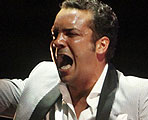Jerez de la Frontera. September 8th 2012
Text: Antonio Conde
Photos: JAVIER FERGO/ reporterosjerez.es
Artistas: Cuadro flamenco 'Jerez Puro', Jesús Méndez, Mercedes Ruiz, Macanita, El Torta, Capullo de Jerez
It probably had all the ingredients to make this Fiesta de la Bulería as good as that of any other year. A Jerez program though and through featuring this generation’s idols doing Jerez-style bulerías…the reason this event was created forty-five years ago. But despite the apparently magnificent program, the organization failed to heed these times of economic troubles which hitting Jerez harder than elsewhere. Tickets were expensive, and this translated into fewer than 1400 people in attendance at the large bull-ring. A devastating blow that seems to suggest this format needs to be redesigned in order to at least preserve the feeling of former years.
This year’s edition was a tribute to its creator, Juan de la Plata, a flamenco activist who has done so much and given so generously to the flamenco of Jerez. He was unable to be present due to medical reasons, but the presenter gave a biographical sketch.
After the presentation, a traditional group made up of local artists opened the program: Luis de Pacote, Jose Méndez, Mara Rey, Tamara de Tañé, Lorenzo Gálvez 'Ripoll', Pepe de la Joaquina, Juanillorro and Luis Moneo to offer Jerez-style bulerías while people continued to arrive, take their seats and line up at the bar.
If anything good came of the low attendance, the worst box-office in the history of the Fiesta de la Bulería, it was that people concentrated down in the ring so the warmth of the audience was transmitted to the stage. Artistically, the night began well but only went downhill.
It was Jesús Méndez on his own who showed where he gets his inspiration and the musical influences he clings to in order to demonstrate he is a star. He presented a preview of his new record “Añoranza”. Warming up with alegrías, using classic verses for soleá apolá of Charamusco. Jesús has a very big voice which he dominates to perfection as demonstrated in the siguiriya de Frijones, “Santolio le den”, a seldom-heard style that Méndez is popularizing, to finish off with the cabal of Serna, and the singer’s intensity was a high point of the night. Fandangos, some of them away from the microphone which is when you appreciate the singer’s lung-power. With the audience silent, it was like going back in time when people sang in bull-rings without amplification. Excellent. Naturally, he ended with bulerías de Jerez. Manuel Valencia on guitar is worth a paragraph of his own; a young talent with the flavor of Jerez. Compás was kept by Diego Amaya and Manuel Salado.
Juan Moneo Lara, also known as El Torta, came on stage. He already seemed on-edge in the dressing-room – the audience’s curiosity about what condition he would appear in would be satisfied in brief minutes. It was neither earth-shaking nor bottom of the barrel. Juan was in good form with a few great moments. He’s a grab-bag of surprises. With Periquín Niño Jero on guitar he sang alegrías, soleá, rumba, tangos of el Pica and bulerías. But Juan was in a patriotic Jerez mood…he insisted on not being recorded by Onda Jerez until they perfect their systems, and threatened to walk off stage or sing a taranto, but not only for the moment, but one which would go on to receive a Lámpara Minera. He even sang a bit of the pop song “Bulería Bulería” of David Bisbal. Delivering the goods, he delighted his fans.
Before the intermission there was time for dance. I still think this isn’t the best place to show dancing, whether from Jerez or elsewhere, and not only because it’s an event that has always been given over to bulerías singing, but because it’s simply not a good venue for the purpose, and the yearly Festival de Jerez is already a dance showcase.
Mercedes Ruiz and company gave it their best shot so that the Torta magic would not dissipate. Mercedes did siguiriyas and alegrías, the first, earthy but technical and measured, the second, lively and suggestive although overly long. David Carpio and an impressive David Lagos provided the cante, while Santiago Lara and Paco Lara were on guitar and Perico Navarro did the percussion.
As of today, Tomasa Guerrero “La Macanita” is the best female voice of Jerez. Her credentials are well-known, and she rarely has anything new to offer. And why should she? Tientos tangos, soleá, malagueña and bulerías. A classic repertoire that sounds different every time we hear it; that’s the good thing about flamenco. However, she didn’t seem to be enjoying herself despite singing well. She closed with bulerías dedicated to Moraíto and Terremoto, accompanied on guitar by Manuel Valencia, and Gregorio, Chícharo and Macano on compás.
The final portion of the 45th edition of the Fiesta de la Bulería was reserved for Capullo de Jerez. He tends to get everyone worked up, and so it was; he’s an idol for the general public who love his rumbas and bulerías. With his voice noticeably hoarse, he opened with soleá por bulería. Briefly, because he immediately got into his festive repertoire which is what the audience always demands. There was a medley of his best-known creations and he closed with bulerías. He definitely contacted with the audience and had them dancing for a good half-hour.
A fiesta finale included some of the artists who had performed, and in this way the worst-attended Fiesta de la Bulería in history came to an end. All that remained was the memory of Capullo and Torta with their improvised bulerías dancing, full of good humor and compás.
